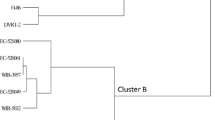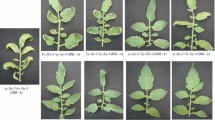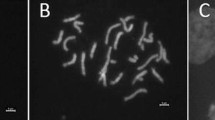Abstract
Genetic diversity during prebreeding or postbreeding programme, is the key pillar to characterize the valuable traits and gene of interest. Whereas, superior or inferior heterotic performance of \(\hbox {F}_{1}\) depend on the diverse nature of their pedigree. Therefore, the aim of this study was to see the diversity between the interspecific crosses and effect of heterosis, and inheritance for the morphological traits and ToLCV resistance. All the 24 \(\hbox {F}_{1}\) interspecific crosses were classified into four clusters on the basis of morphological traits as well as simple sequence repeat (SSR) markers. Among the \(\hbox {F}_{1}\) hybrids, 23 were grouped into clusters II, III and IV with different phylogeny, while \(\hbox {PBC} \times \) EC 521080 was individual with cluster I. On the basis of visual observation of fruit colour, deep red and green colours in the crosses of S. pimpinellifolium (EC 521080) and S. habrochaites (EC 520061) exhibited dominant effects. In context of heterosis breeding, the crosses which were made using Solanum pimpinellifolium (EC 521080), S. chmielewskii (EC 520049) and S. cerasiforme (EC 528372) were better for yield capacity and the crosses of S. habrochaites (EC 520061) exhibited low and negative heterosis for ToLCV resistance. The \(\hbox {F}_{2}\) progenies were segregated in various Mendelian ratio as follows 3:1, 1:2:1, 1:3, 13:3, 15:1, 12:3:1 and 9:6:1 for ToLCV disease reaction of incidence, plant growth habit and fruit colour appearance, respectively. Therefore, these interspecific crosses can be utilized for developing high yield, impressive fruit colour combiners and resistant hybrids/varieties of tomato.


Similar content being viewed by others
References
Anbinder I., Reuveni M., Azari R., Ilan P., Nahon S., Shlomo H. et al. 2009 Molecular dissection of tomato leaf curl virus resistance in tomato line TY172 derived from Solanum peruvianum. Theor. Appl. Genet. 119, 519–530.
Banerjee M. K. and Kalloo G. 1987a Sources and inheritance of resistance leaf curl virus in lycopersicon. Theor. Appl. Genet. 73, 707–710.
Banerjee M. K. and Kalloo G. 1987b Inheritance of tomato leaf curls virus resistance in Lycopersicon hirsutum f. glabratum. Euphytica 36, 581–584.
Banerjee M. K. and Kalloo G. 1989 The inheritance of earliness and fruit weight in crosses between cultivated tomatoes and two wild species of Lycopersicon. Plant Breed. 102, 148–152.
Borah B. K. and Dasgupta I. 2012 Begomovirus research in India: a critical appraisal and the way ahead. J. Biosci. 37, 791–806.
Britton G. 1998 Overview of carotenoid biosynthesis: In Carotenoids (ed. G. Britton, S. Liaaen-Jensen and H. Pfander) vol. 3, pp. 33–147. Birkhäuser-Verlag, Basel.
de Castro A. P., Julian O. and Diez M. J. 2013 Genetic control and mapping of Solanum chilense LA1932, LA1960 and LA1971-derived resistance to tomato yellow leaf curl disease. Euphytica 190, 203–214.
Doyle J. J. and Doyle J. L. 1990 A rapid DNA isolation procedure from small quantity of fresh leaf material. Phytochem. Bull. 119, 11–15.
Frary A., Xu Y., Liu J., Mitchell S., Tedeschi E. and Tanksley S. D. 2005 Development of a set of PCR-based anchor markers encompassing the tomato genome and evaluation of their usefulness for genetics and breeding experiments. Theor. Appl. Genet. 111, 291–312.
Fraser P. D., Truesdale M. R., Bird C. R., Schuch W. and Bramley P. M. 1994 Carotenoid biosynthesis during tomato development. Plant Physiol. 105, 405–413.
Foolad M. R. 2007 Genome mapping and molecular breeding of tomato. Int. J. Plant Genom. Article ID 64358.
Fulton T. M., Nelson J. C. and Tanksley S. D. 1997 Introgression and DNA marker analysis of Lycopersicon peruvianum, a wild relative of the cultivated tomato, into Lycopersicon esculentum, followed through three successive backcross generations. Theor. Appl. Genet. 95, 895–902.
Giuliano G., Bartley G. E. and Scolnik P. A. 1993 Regulation of carotenoid biosynthesis during tomato development. Plant Cell 5, 379–387.
Grandillo S., Chetelat R., Knapp S., Spooner D., Peralta I., Cammareri M. et al. 2011 From Solanum sect. Lycopersicon. In Wild crop relatives: genomic and breeding resources. Vegetables (ed. C. Kole), 1st edition, pp. 129–215. Springer, Berlin, Heidelberg, New York.
Hanson P., Green S. K. and Kuo G. 2006 Ty-2, a gene on chromosome 11 conditioning geminivirus resistance in tomato. Rep. Tomato Genet. Coop. 56, 17–18.
Hegde V. S. 2010 Genetics of flowering time in chickpea in a semi-arid environment. Plant Breed. 129, 683–687.
Jordaan J. P., Engelbrecht S. A., Malan J. H. and Knobel H. A. 1999 Wheat and heterosis. In The genetics and exploitation of heterosis in crops (ed. J. G. Coors and S. Pandey), pp. 411–421. ASA, CSSA, and SSSA, Madison.
Kader A. A. 1996 Maturity, ripening and quality relationships of fruit-vegetables. Acta Hortic. 434, 249–255.
Kalloo G. and Banerjee M. K. 1990 Transfer of tomato leaf curl virus resistance from Lycopersicon hirsutum f. glabratum to L. esculentum. Plant Breed. 105, 156–159.
Kaur G., Bansal P., Kaur B. and Banga S. 2007 Genetic diversity and its association with heterosis in Brassica rapa. In Proceedings of the 12th International Rapeseed Congress, vol. I, pp. 144–146, 6–30 June 2007. Wuhan, China.
Lippman Z. B. and Zamir D. 2007 Heterosis: revisiting the magic. Trends Genet. 23, 60–66.
Liu L., Wang Y., Gong Y., Zhai X., Yu F. and Shen H. 2008 Genetic purity test of F1 hybrid tomato using molecular marker analysis. Acta Hortic. 771, 231–238.
Lumpkin H. 2005. A comparison of lycopene and other phytochemicals in tomatoes grown under conventional and organic management systems. Technical Bulletin No. 34. AVRDC publication number 05-623, AVRDC-The World Vegetable Center, pp. 48. Shanhua, Taiwan.
Miller J. C. and Tanksley S. D. 1990 RFLP analysis of phylogenetic relationships and genetic variation in the genus Lycopersicon. Theor. Appl. Genet. 80, 437– 448.
Muniyappa V., Padmaja A. S., Venkatesh H. M., Sharma A., Chandrasekhar S., Kulkarni R. S. et al. 2002 Tomato leaf curl virus resistance tomato lines TLB111, TLB130, and TLB182. Hortic. Sci. 37, 603–606.
Peralta I. E., Spooner D. M., Razdan M. K., Mattoo A. K. 2007 History, origin and early cultivation of tomato (Solanaceae). In Genetic improvement of solanaceous crops (Tomato), vol. 2, pp. 1–27. N. H. Science Publishers, Enfield.
Pico B., Diez M. and Nuez F. 1998 Evaluation of whitefly-mediated inoculation techniques to screen Lycopersicon esculentum and wild relatives for resistance to tomato yellow leaf curl virus. Euphytica 101, 259–271.
Rajput Y. S., Rai N., Yadav R. K. and Asati B. S. 2003 Line x Tester analysis in tomato. J. Assam Sci. Soc. 44, 32–39.
Rao A. V. and Agarwal S. 2000 Role of antioxidant lycopene in cancer and heart disease. J. Am. Coll. Nutr. 19, 563–569.
Rohlf F. J. 1994 NTSYS-pc, numerical taxonomy and multivariate analysis system version 2.2. State University, New York, New York.
Shankarappa K. S., Sriharsha R. K. T., Aswathanarayana D. S., Prameela H. A., Kulkarni R. S., Muniyappa V. et al. 2008 Development of tomato hybrids resistant to tomato leaf curl virus disease in South India. Euphytica 164, 531–539.
Sharma A., Zhang L., Ni no-Liu D., Ashrafi H., Foolad M. R. 2008 A Solanum lycopersicum \(\times \) Solanum pimpinellifolium linkage map of tomato displaying genomic locations of R-genes, RGAs, and candidate resistance/defense-response ESTs. Int. J. Plant Genomics. Article ID 926090.
Singh R. K., Rai N., Singh M., Singh S. N. and Srivastava K. 2014 Genetic analysis to identify good combiners for ToLCV resistance and yield components in tomato using inter-specific hybridization. J. Genet. 93, 623–629.
Singh R. K., Rai N., Singh M., Saha S. and Singh S. N. 2015a Detection of tomato leaf curl virus resistance and inheritance in tomato (Solanum lycopersicum L.). J. Agric. Sci. Cambridge. 153, 78–89.
Singh R. K., Rai N., Singh M., Singh S. N., Srivastava K. 2015b Selection of resistance genotypes of tomato against tomato leaf curl virus (ToLCV) disease using biochemical and physiological approaches. J. Agric. Sci. Cambridge. 153, 646 – 655.
Singh R. K., Rai N., Singh M., Singh R. and Kumar P. 2015c Effect of climate change on tomato leaf curl virus (ToLCV) disease in tomato. Ind. J. Agric. Sci. 85, 290–292.
Singh R. K., Rai N., Kumar P. and Singh A. K. 2015d Inheritance study in tomato (Solanum lycopersicum) for Tomato leaf curl virus (ToLCV) resistance. Ind. J. Agric. Sci. 85, 896–901.
Sneath P. H. and Sokal R. R. 1973 Numerical taxonomy: the principles and practice of numerical classification, 1st edition. W. H Freeman, San Francisco.
Solankey S. S., Singh A. K. and Singh R. K. 2013 Genetic expression of heterosis for yield and quality traits during different growing seasons in okra (Abelmoschus esculentus). Ind. J. Agric. Sci. 83, 815–819.
Tanksley S. D., Ganal M. W., Prince J. P., De Vicente M. C., Bainerbale M. W., Broun P. et al. 1992 High density molecular linkage maps of tomato and potato genomes. Biol. Infer. Pract. Appl. Genet. 123, 1141–1160.
Varshney R. K., Graner A. and Sorrells M. E. 2005 Genic microsatellite markers in plants: features and applications. Trends Biotechnol. 23, 48–55.
Vidavski F., Czosnek H., Gazit S., Levy D. and Lapidot M. 2008 Pyramiding of genes conferring resistance to tomato yellow leaf curl virus from different wild tomato species. Plant Breed. 127, 625–631.
Acknowledgements
We thank ICAR-IIVR, Varanasi for facilities provided during the experiments.
Author information
Authors and Affiliations
Corresponding author
Additional information
Corresponding editor: Umesh C. Lavania
Rights and permissions
About this article
Cite this article
Singh, R.K., Rai, N., Singh, A.K. et al. Elucidation of diversity among \(\hbox {F}_{1}\) hybrids to examine heterosis and genetic inheritance for horticultural traits and ToLCV resistance in tomato. J Genet 97, 67–78 (2018). https://doi.org/10.1007/s12041-018-0904-1
Received:
Revised:
Accepted:
Published:
Issue Date:
DOI: https://doi.org/10.1007/s12041-018-0904-1




